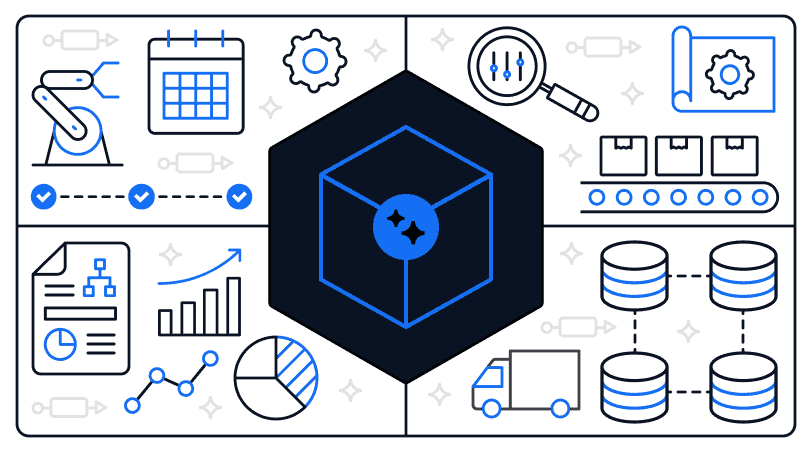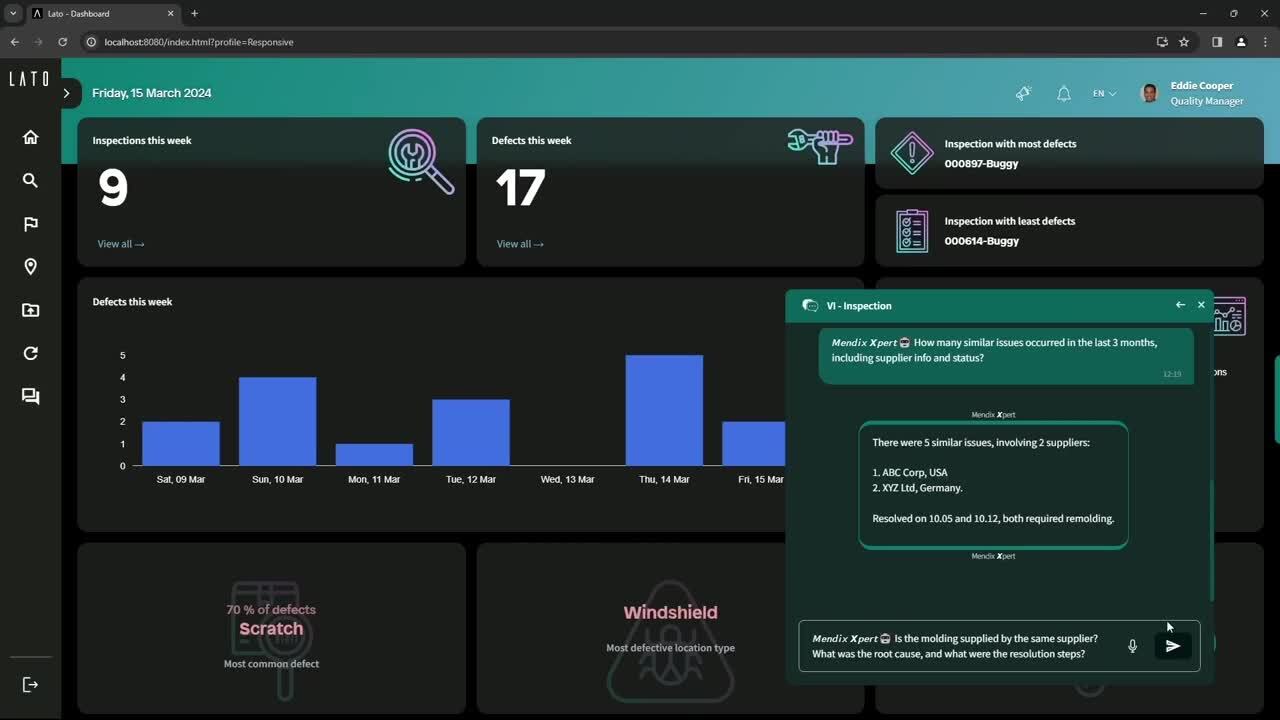Reimagine Industrial AI with Low-Code

AI, ML, GenAI. You see these terms everywhere these days. It makes you want to shout, “Alexa, Siri, ChatGPT, somebody! Please tell me what these mean.”
Well, I’m only human, but allow me to offer you some definitions. And then I’m going to introduce you to a fourth term that you’ll be seeing a lot more of in the future.
- AI (Artificial Intelligence): A technology that can perform human-like tasks. (Alexa and Siri were for many consumers their first introduction to AI.)
- ML (Machine Learning): A branch of AI technology that uses algorithms to analyze data, learns from that data, and uses that data to make predictions about future data. (Alexa and Siri use machine learning to improve their performance and to adapt themselves to their users’ preferences.)
- GenAI (Generative Artificial Intelligence): Another branch of AI that uses machine learning to create new content. (ChatGPT is probably the best-known example of GenAI technology.)
Simple enough, right? (Maybe next time we’ll dive into the real fun stuff like deep learning, neural networks, and supervised and unsupervised learning.)
I’ve defined those three terms for you because they’re all relevant to that fourth term I promised: Industrial AI.
Introduction to Industrial AI
Industrial AI refers to the use of AI technologies in industry. These uses could include:
- Augmenting the workforce
- Enhancing customer service
- Creating more sustainable products
- Designing more sustainable processes
When I talk to people about the way manufacturers are using Industrial AI, I like to divide those uses into four categories: Optimization, Prediction, Discovery, and Transparency. Let’s take a closer look at each of those categories.
Optimization
Manufacturers are constantly searching for ways to optimize their systems. Each optimization can boost an entire chain of processes.
- Assembly line optimization leads to production schedule optimization leads to manufacturing optimization
- Material handling optimization leads to inventory optimization leads to supply chain optimization
Manufacturers use simulation technologies to optimize their processes. These technologies create a digital twin of a factory that models all its operations. These simulations can expose the bottlenecks choking production.
AI then churns through both the synthetic data generated by the digital twin and the real-life sensor data generated by the factory. It uses the data to plot the most efficient paths for eliminating those bottlenecks.
Prediction
Manufacturers are constantly peeking into the future. They need to anticipate things like:
- How marketplace demands will change
- How those demands will affect their production
- How their equipment will hold up to shifts in production
The best way for manufacturers to prepare for the future is to accurately predict it.
Predictions are based on patterns of causes and effects. Machine learning programs are very talented at detecting patterns. They investigate huge data sets, make guesses about how the data interact, test their guesses, and make more guesses based on what they’ve learned. Eventually they become experts on the patterns in those data sets. They can then use those patterns to make predictions within that data set.
For example, a manufacturer collects sensor data from a segment of an assembly line. That sensor data can contain everything from conveyor belt speed to ball bearing temperatures to motor vibrations. The manufacturer feeds all that data, along with data about the segment’s repair history, into a machine learning program.
The program can then search the data for patterns on when the segment broke down and what factors led to that breakdown. Once it’s figured out the patterns, it can predict when and why the segment would most likely break down again.
The manufacturer then can create a maintenance schedule that prevents that breakdown before it can occur. Predictive maintenance can save not only on the costs of major repairs, but also preserve the revenue that would have been lost from a shutdown of production.
Discovery
As we’ve seen from our examples so far, manufacturers have access to a lot of data, almost too much data. To consume this data, they use dashboards that visualize that data in a hundred different ways. But the most sophisticated of dashboards won’t solve the problem of not having enough eyes or time to discover what that data is saying.
That’s where GenAI can help. We learned that machine learning is an expert at analyzing data. What GenAI is an expert at is creating meaningful knowledge from that analysis and sharing it in a way that’s easy to understand.
The same way that ChatGPT can instantly give you a three-paragraph summary of the nesting habits of an Emperor penguin, an industrial GenAI program can give a supply chain manager a quick but comprehensive summary of the effects of a shipping backlog at a Singaporean port.
One of the main benefits of using GenAI to make data discoveries is that you don’t need to use special encoding to phrase your discovery request or to be an expert in graphic analysis to understand the results from your request. GenAI understands and communicates in natural language. Ask a simple (or complicated!) question, and get a simple answer.
And GenAI is not limited to simple natural language summaries. It can also generate different formats of textual information, such as instructional sets, and graphical information, such as plots and graphs.
Transparency
Data is only useful to manufacturers when it’s transparent or, in other words, easy to find. But it’s the most useful when they can also share it. We’ve seen how AI can help manufacturers make their own data transparent. GenAI and machine learning tools can also help manufacturers and their partners make their data transparent to each other.
For instance, a manufacturer of electric vehicle batteries must keep tabs on a very complicated supply chain. Its battery has a thousand different parts coming in from a host of suppliers. The manufacturer also needs to secure raw materials such as nickel, cobalt, and copper from around the globe. To stay in compliance with the numerous regulations its subjected to, the battery manufacturer needs transparency into how its partners are conducting their operations.
But even when supply chain partners openly share access to their data with each other, it’s even more difficult to find the information you need in someone else’s data stream than it is to find it in your own. Machine learning tools once again serve as our experts at finding, sorting, and classifying data. And our GenAI tools free us from having to invest in a different set of dashboards for each incoming data stream. We can just ask for what we’re looking for, and the GenAI will deliver it to us in the format we need.
Check all your data and democratization boxes with low-code
All of this might sound simple when boiled down in an article. But the reality is that Industrial AI feeds on massive amounts of data. And data management is never simple. You need your data to be freely accessible to your AI systems while still abiding by the constraints of security, regulatory, and data sharing policies.
Manufacturers who want to make the best use of Industrial AI, then, need to find ways to make their data easy to:
- Access
- Format
- Govern
- Integrate
- Keep safe and private
A low-code application development platform checks all those boxes. Mendix makes your data management simple through its own use of AI.
MxAssist, our suite of AI-assisted development bots, gives you a helping hand in building intuitive and powerful low-code data management applications. Trained from the analysis of over 12 million anonymized application logics, it provides real-time, context-driven recommendations while you compose your applications.
MxAssist offers:
- AI-assisted application modelling and logic
- AI-enforced best practices audits
- AI-automated validation logic
And Mendix is the only low-code platform that offers effortless AI/ML integration with external cognitive services. Mendix seamlessly connects to third-party cognitive services from Amazon, Microsoft, Google, OpenAI, Stability AI, and others. You can embed into your Mendix applications the results from machine learning training frameworks such as TensorFlow, Caffe, and PyTorch.
Mendix makes it especially easy for you to integrate with the market-leading AI services from Amazon, including:
- Amazon Textract
- Amazon Rekognition
- AWS IoT TwinMaker
- Amazon Polly
- Amazon Bedrock
You can simply drag and drop the service connector into your Mendix application without the complexities of REST APIs or code.

This drag-and-drop capability is an example of another advantage Mendix offers as a platform for implementing your Industrial AI initiatives. Its intuitive graphical user interface lets your subject matter experts participate in the initiative, regardless of their application development skills.
Mendix democratizes your use of simulation models and data accessibility by offering simple abstractions of their engagement experiences. When your shopfloor operators can effortlessly participate in setting the parameters for your digital twin and AI models, you get more accurate and more applicable data results.
Keep in mind that while AI can be a versatile and potent tool, it is not the answer for all industrial use cases without data and purpose. But if you think it could elevate your operations, reach out to us today to learn how you can power your industrial AI initiative with Mendix.
